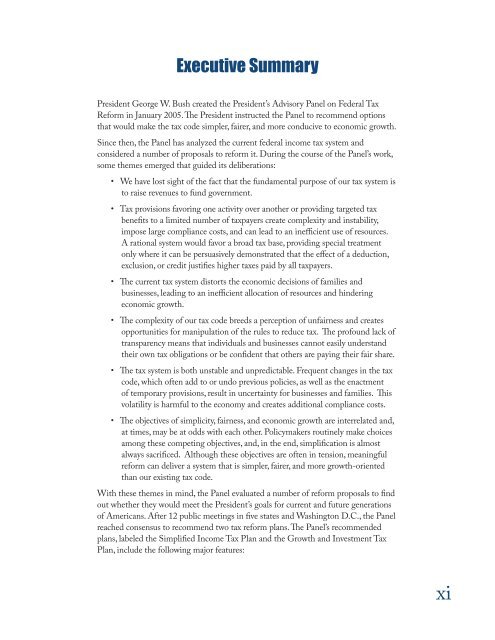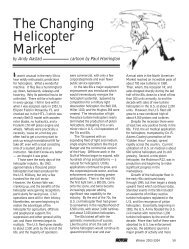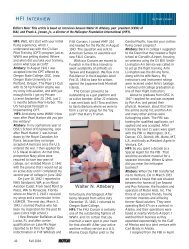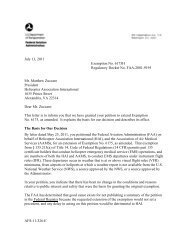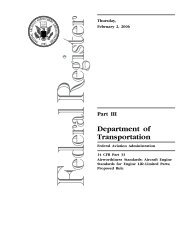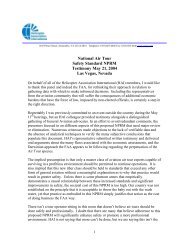recommend
recommend
recommend
Create successful ePaper yourself
Turn your PDF publications into a flip-book with our unique Google optimized e-Paper software.
Executive Summary<br />
President George W. Bush created the President’s Advisory Panel on Federal Tax<br />
Reform in January 2005. The President instructed the Panel to <strong>recommend</strong> options<br />
that would make the tax code simpler, fairer, and more conducive to economic growth.<br />
Since then, the Panel has analyzed the current federal income tax system and<br />
considered a number of proposals to reform it. During the course of the Panel’s work,<br />
some themes emerged that guided its deliberations:<br />
• We have lost sight of the fact that the fundamental purpose of our tax system is<br />
to raise revenues to fund government.<br />
• Tax provisions favoring one activity over another or providing targeted tax<br />
benefits to a limited number of taxpayers create complexity and instability,<br />
impose large compliance costs, and can lead to an inefficient use of resources.<br />
A rational system would favor a broad tax base, providing special treatment<br />
only where it can be persuasively demonstrated that the effect of a deduction,<br />
exclusion, or credit justifies higher taxes paid by all taxpayers.<br />
• The current tax system distorts the economic decisions of families and<br />
businesses, leading to an inefficient allocation of resources and hindering<br />
economic growth.<br />
• The complexity of our tax code breeds a perception of unfairness and creates<br />
opportunities for manipulation of the rules to reduce tax. The profound lack of<br />
transparency means that individuals and businesses cannot easily understand<br />
their own tax obligations or be confident that others are paying their fair share.<br />
• The tax system is both unstable and unpredictable. Frequent changes in the tax<br />
code, which often add to or undo previous policies, as well as the enactment<br />
of temporary provisions, result in uncertainty for businesses and families. This<br />
volatility is harmful to the economy and creates additional compliance costs.<br />
• The objectives of simplicity, fairness, and economic growth are interrelated and,<br />
at times, may be at odds with each other. Policymakers routinely make choices<br />
among these competing objectives, and, in the end, simplification is almost<br />
always sacrificed. Although these objectives are often in tension, meaningful<br />
reform can deliver a system that is simpler, fairer, and more growth-oriented<br />
than our existing tax code.<br />
With these themes in mind, the Panel evaluated a number of reform proposals to find<br />
out whether they would meet the President’s goals for current and future generations<br />
of Americans. After 12 public meetings in five states and Washington D.C., the Panel<br />
reached consensus to <strong>recommend</strong> two tax reform plans. The Panel’s <strong>recommend</strong>ed<br />
plans, labeled the Simplified Income Tax Plan and the Growth and Investment Tax<br />
Plan, include the following major features:<br />
xi
The President’s Advisory Panel on<br />
Federal Tax Reform<br />
• Simplification of the entire tax system and streamlined tax filing for both<br />
families and businesses.<br />
• Lower tax rates on families and businesses, while retaining the progressive<br />
nature of our current tax system.<br />
• Extension of important tax benefits for home ownership and charitable giving<br />
to all taxpayers, not just the 35 percent who itemize; extension of tax-free<br />
health insurance to all taxpayers, not just those who receive insurance from<br />
their employers.<br />
• Removal of impediments to saving and investment.<br />
• Elimination of the alternative minimum tax, which is projected to raise the<br />
taxes of more than 21 million taxpayers in 2006 and 52 million taxpayers by<br />
2015.<br />
The two plans differ in the taxation of businesses and capital income. Although they<br />
use different approaches, the plans share a common goal of providing simple and<br />
straightforward ways for Americans to save free of tax and lower the tax burden on<br />
productivity-enhancing investment by businesses.<br />
A table outlining both tax reform plans follows this summary.<br />
The Panel also developed and considered a progressive consumption tax plan that<br />
would be administered using the infrastructure of our familiar tax system, but was<br />
unable to reach a consensus to include it as a <strong>recommend</strong>ation. The Panel also<br />
considered ideas for a value-added tax and a national retail sales tax, and decided not<br />
to <strong>recommend</strong> either approach.<br />
The Simplified Income Tax Plan and the Growth and Investment Tax Plan put<br />
forward by the Panel achieve the goals set by the President in a number of ways.<br />
They reduce complexity by:<br />
• Allowing every taxpayer to use a simple tax form, which is less than half the<br />
length of the current Form 1040.<br />
• Combining 15 different tax provisions for at-work saving, health saving,<br />
education saving, and retirement saving into three simple saving plans.<br />
• Eliminating a complicated set of phase-outs that leave taxpayers wondering<br />
whether they are eligible to benefit from numerous provisions.<br />
• Replacing a confusing, full-page worksheet for seniors reporting Social<br />
Security income with a simple computation that is no more than six lines.<br />
• Replacing the complicated rules for small business with a system that is based<br />
on the records their owners already keep.<br />
xii
They improve fairness by:<br />
• Ensuring that tax benefits are easily understood and accessible, thereby<br />
increasing confidence in the tax system.<br />
• Making most tax benefits available to all taxpayers, not just the 35 percent who<br />
itemize.<br />
• Shifting some tax preferences from deductions, which tend to benefit highincome<br />
households, to tax credits, which benefit all taxpayers equally.<br />
• Reducing marriage penalties by ensuring that the rate brackets, the Family<br />
Credit, and the taxation of Social Security benefits for married couples are<br />
twice the amounts for singles.<br />
• Transforming the earned income tax credit and savers credit into provisions<br />
that are more accessible and beneficial to low income taxpayers.<br />
• Closing loopholes and eliminating special tax breaks that allow the welladvised<br />
to avoid paying their fair share.<br />
• Maintaining the progressive nature of our tax system.<br />
Executive Summary<br />
They promote economic growth by:<br />
• Reducing the double-tax on corporate profits earned in the United States.<br />
• Promoting savings throughout our economy, especially at the household level.<br />
• Equalizing the tax treatment of several forms of corporate financing, raising<br />
the incentives for companies to issue equity rather than debt to finance growth.<br />
• Lowering the top marginal rates on individuals and large businesses.<br />
• Reducing the likelihood that households or businesses will alter economic<br />
behavior because of special tax preferences or benefits.<br />
• Reducing the paperwork burden for small businesses, and providing them an<br />
immediate write-off for all purchases of new tools and equipment.<br />
• Updating our international tax system.<br />
These benefits will follow only from a fundamental reform of the tax code. In<br />
isolation, some of the <strong>recommend</strong>ed pieces may be controversial, but, taken as<br />
a whole, they accomplish the Panel’s objectives. Each plan is designed to be<br />
comprehensive and should be viewed as an integrated package. The Panel believes<br />
that without large-scale changes, and continued commitment to avoiding complexity<br />
and special tax breaks, the tax code will become even more confusing, unfair, and<br />
damaging to our economy. We urge the Administration and Congress to consider<br />
these <strong>recommend</strong>ations carefully and to move forward with reform.<br />
xiii
The President’s Advisory Panel on<br />
Federal Tax Reform<br />
The Current Tax System<br />
Provisions Current Law (2005)<br />
Households and Families<br />
Tax Rates Six tax brackets: 10%, 15%, 25%, 28%, 33%, 35%<br />
Alternative minimum tax Affects 21 million taxpayers in 2006; 52 taxpayers million in 2015<br />
Personal exemption<br />
Standard deduction<br />
$3,200 deduction for each member of a household; phases out with<br />
income<br />
$10,000 deduction for married couples filing jointly, $5,000 deduction for<br />
singles, $7,300 deduction for heads of households; limited to taxpayers<br />
who do not itemize<br />
Child tax credit $1,000 credit per child; phases out for married couples between $110,000<br />
and $130,000<br />
Earned income tax credit<br />
Marriage penalty<br />
Other Major Credits and Deductions<br />
Provides lower-income taxpayers refundable credit designed to encourage<br />
work. Maximum credit for working family with one child: $2,747; with<br />
two or more children: $4,536<br />
Raises the tax liability of two-earner married couples compared to two<br />
unmarried individuals earning the same amounts<br />
Home mortgage interest<br />
Charitable giving<br />
Health insurance<br />
State and local taxes<br />
Education<br />
Individual Savings and Retirement<br />
Defined contribution plans<br />
Deduction available only to itemizers for interest on up to $1.1 million of<br />
mortgage debt<br />
Deduction available only to itemizers<br />
Grants tax-free status to an unlimited amount of premiums paid by<br />
employers or the self-employed.<br />
Deduction available only to itemizers<br />
HOPE Credit, Lifetime Learning Credit, tuition deduction, student loan<br />
interest deduction; all phase out with income<br />
Available through 401(k), 403(b), 457, and other employer plans<br />
xiv<br />
Defined benefit plans<br />
Retirement savings plans<br />
Education savings plans<br />
Health savings plans<br />
Pension contributions by employers are untaxed<br />
IRAs, Roth IRAs, spousal IRAs – subject to contribution<br />
and income limits<br />
Section 529 and Coverdell accounts<br />
MSAs, HSAs, and Flexible Spending Arrangements<br />
Dividends received Taxed at 15% or less (ordinary rates after 2008)<br />
Capital gains received Taxed at 15% or less (higher rates after 2008)<br />
Interest received (other than tax-exempt<br />
municipal bonds)<br />
Social Security benefits<br />
Small Business<br />
Rates<br />
Recordkeeping<br />
Investment<br />
Large Business<br />
Taxed at ordinary income tax rates<br />
Taxed at three different levels, depending on outside income; marriage<br />
penalty applies<br />
Typically taxed at individual rates<br />
Numerous specialized tax accounting rules for items of income and<br />
deductions<br />
Accelerated depreciation; special small business expensing rules allow<br />
write-off of $102,000 in 2005 (but cut by ¾ in 2008)<br />
Rates Eight brackets: 15%, 25%, 34%, 39%, 34%, 35%, 38%, 35%<br />
Investment<br />
Interest paid<br />
Interest received<br />
International tax system<br />
Corporate AMT<br />
Accelerated depreciation under antiquated rules<br />
Deductible<br />
Taxable<br />
Worldwide system with deferral of business profits and foreign tax credits<br />
Applies second tax system to business income
Executive Summary<br />
How the Tax Code Would Change<br />
Provisions Simplified Income Tax Plan Growth and Investment Tax Plan<br />
Households and Families<br />
Tax Rates Four tax brackets: 15%, 25%, 30%, 33% Three tax brackets: 15%, 25%, 30%<br />
Alternative minimum tax<br />
Personal exemption<br />
Standard deduction<br />
Child tax credit<br />
Earned income tax credit<br />
Marriage penalty<br />
Other Major Credits and Deductions<br />
Home mortgage interest<br />
Charitable giving<br />
Health insurance<br />
Education<br />
State and local taxes<br />
Individual Savings and Retirement<br />
Defined contribution plans<br />
Repealed<br />
Replaced with Family Credit available to all taxpayers: $3,300 credit for married couple, $2,800 credit for unmarried<br />
with child, $1,650 credit for singles, $1,150 credit for dependent taxpayer; additional $1,500 credit for each child and<br />
$500 credit for each other dependent<br />
Replaced with Work Credit (and coordinated with the Family Credit); maximum credit for working family with one<br />
child: $3,570; with two or more children, $5,800<br />
Reduced. All tax brackets, Family Credits, and taxation of Social Security benefits for couples are<br />
double those of individuals<br />
Home Credit equal to 15% of mortgage interest paid; available to all taxpayers; mortgage limited to average regional<br />
price of housing (limits ranging from about $227,000 to $412,000)<br />
Deduction available to all taxpayers (who give more than 1% of income); rules to address valuation abuses<br />
All taxpayers may purchase health insurance with pre-tax dollars, up to the amount of the average premium<br />
(estimated to be $5,000 for an individual and $11,500 for a family)<br />
Taxpayers can claim Family Credit for some full-time students; simplified savings plans<br />
Not deductible<br />
Consolidated into Save at Work plans that have simple rules; AutoSave features point workers in a pro-saving direction<br />
Defined benefit plans<br />
Retirement savings plans<br />
Education savings plans<br />
Health savings plans<br />
No change<br />
Replaced with Save for Retirement Accounts ($10,000 annual limit) – available to all taxpayers<br />
Replaced with Save for Family Accounts ($10,000 annual limit); would cover education, medical, new home costs, and<br />
retirement saving needs; available to all taxpayers; refundable Saver’s Credit available to low-income taxpayers<br />
Dividends received<br />
Capital gains received<br />
Interest received (other than<br />
tax exempt municipal bonds)<br />
Exclude 100% of dividends of U.S. companies<br />
paid out of domestic earnings<br />
Exclude 75% of corporate capital gains from U.S.<br />
companies (tax rate would vary from 3.75% to 8.25%)<br />
Taxed at regular income tax rates<br />
Taxed at 15% rate<br />
Taxed at 15% rate<br />
Taxed at 15% rate<br />
Social Security benefits<br />
Small Business<br />
Replaces three-tiered structure with simple deduction. Married taxpayers with less than $44,000 in income<br />
($22,000 if single) pay no tax on Social Security benefits; fixes marriage penalty; indexed for inflation<br />
Rates Taxed at individual rates (top rate has been lowered to 33%) Sole proprietorships taxed at individual rates<br />
(top rate lowered to 30%);<br />
Other small businesses taxed at 30%<br />
Recordkeeping Simplified cash-basis accounting Business cash flow tax<br />
Investment<br />
Expensing (exception for land and buildings under the Simplified Income Tax Plan)<br />
Large Business<br />
Rates 31.5% 30%<br />
Investment Simplified accelerated depreciation Expensing for all new investment<br />
Interest paid No change Not deductible (except for financial institutions)<br />
Interest received No change Not taxable (except for financial institutions)<br />
International tax system Territorial tax system Destination-basis (border tax adjustments)<br />
Corporate AMT<br />
Repealed<br />
xv


